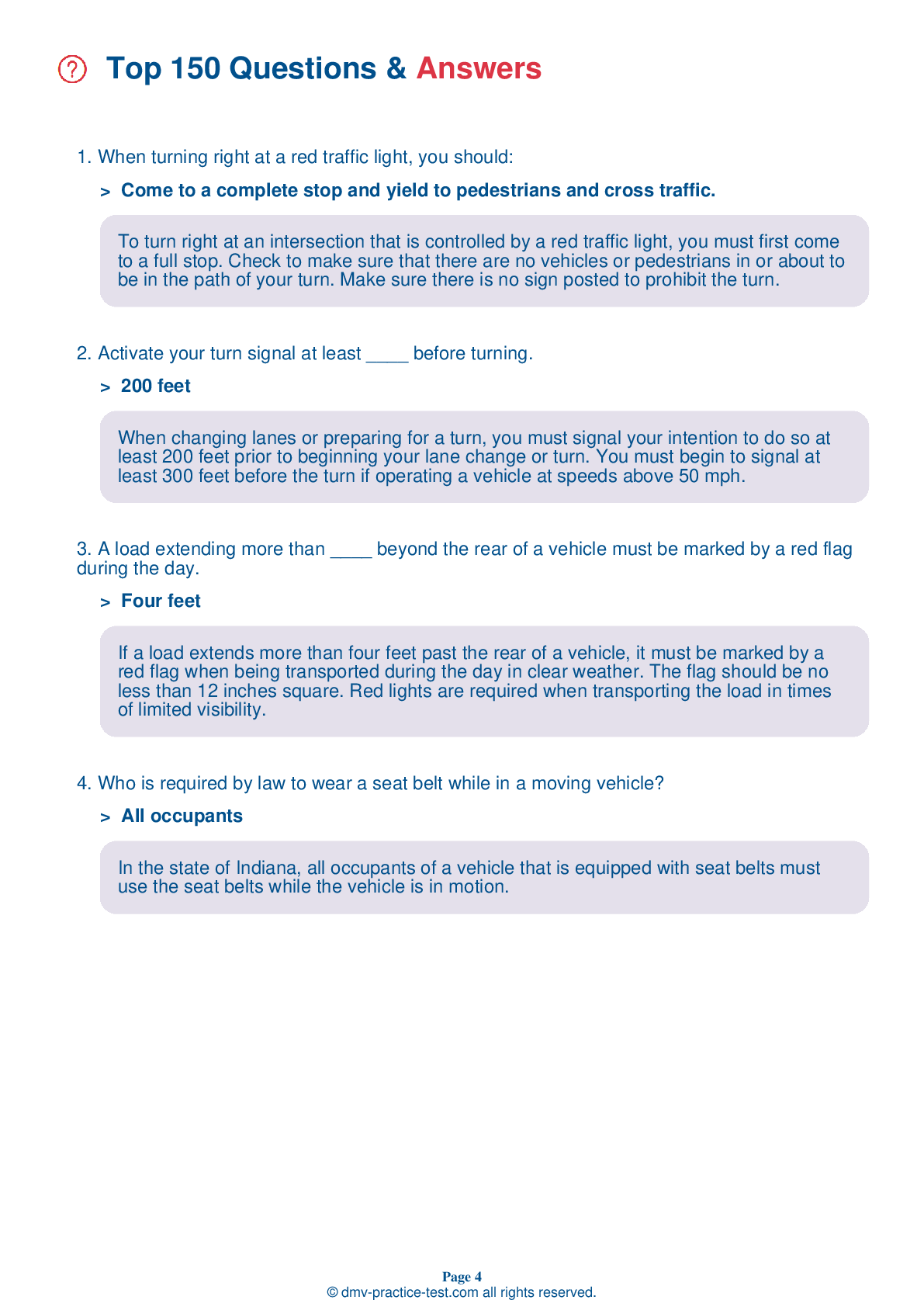FREE Indiana DMV Practice Test #20 Page 3 of 5
This set of Indiana DMV practise tests has been updated for January 2025. It includes questions based on the Indiana Driver Handbook's most significant traffic signals and laws for 2025. Use actual questions that are very similar (often identical!) to the DMV driving permit test and driver's licence exam to study for the DMV driving permit test and driver's licence exam.
On the practise exam, each question gets a tip and explanation to help you remember the concepts. The written component of the official Indiana DMV test will include questions about traffic rules, traffic signs, and driving statutes, as well as information from the Driver Handbook.
To obtain a passing grade, you must correctly answer 44 of the 50 questions. Take our DMV practise exam to help you prepare for your Indiana instruction permit or driver's licence.
The DMV exam is available in several languages.
Using any kind of testing assistance will result in an automatic fail, and the DMV may take additional action against your driver's licence, so stay away from it.
17 . If your car breaks down on a highway, you should:
If your vehicle breaks down on the highway, you should signal before carefully exiting the roadway and turning on your hazard flashers. Get as far off the road as possible and park in a location where other drivers can easily see you. Lift your hood to let other drivers know your vehicle is disabled.
18 . An arrow painted on the pavement means:
An arrow painted on the pavement within a traffic lane indicates that drivers in the lane must make the movement indicated by the arrow. Drivers should follow directions given by any traffic signs or signals before proceeding in the direction indicated by the arrow.
19 . When driving on slick roads, you should:
While it is always dangerous to drive too fast on slippery roads, this is especially true when driving in turns and curves. Be sure to approach them more slowly in slippery conditions than you would under normal circumstances.
20 . This sign means:

Construction zones pose dangers to both drivers and construction workers. Orange highway construction signs warn drivers to be careful when encountering construction zones. This sign tells drivers that a work crew may be in or near the roadway and that they should proceed with extraordinary caution.
21 . If a flagger is directing traffic in a construction zone, you must:
Be prepared to reduce your speed and use caution when directed to do so by a sign, flagger, or law enforcement officer. Failure to do so is illegal and is dangerous to those working in construction zones.
22 . If an emergency vehicle with flashing lights is traveling in the area where you are driving, you should:
If an emergency vehicle with flashing lights is traveling in the area where you are driving, you must make every effort to give them a clear path of travel. If it is safe to do so, pull your vehicle to the side of the road to give the emergency vehicle an open pathway.
23 . Safely passing another vehicle requires a driver to:
When changing lanes, be sure that there is no traffic ahead in the lane that you would like to enter. Check your mirrors for any other drivers that are preparing to pass you. Briefly turn your head toward the lane that you are entering to make sure that there is not a vehicle in your blind spot and that there is sufficient room to move into the adjacent lane.
24 . If someone has consumed alcoholic drinks, what will help the person overcome the influence of those drinks?
Only the passage of time will allow a person to overcome the influence of alcohol.
25 . What does a single dashed white line separating traffic mean?
White lines separate lanes of traffic that are moving in the same direction. Dashed white lines may be crossed to pass or change lanes, if it is safe to do so.
26 . A person who drives much slower than the speed limit:
Driving more slowly than the flow of traffic can be hazardous. If you are on a two-lane, two-way road and driving so slowly that traffic is backing up behind you, you are required to pull off the road and let the other vehicles pass. Only drive significantly under the speed limit when conditions require it.
27 . Your ability to stop is affected by:
Your ability to stop is greatly affected by the condition of the road. You need to reduce your speed when road conditions are poor in order to maintain control of your vehicle. You will be at risk if you are driving too quickly on roads that are slippery and you need to stop.
Need Car Insurance? No problem!
Compare the best rates in Indiana and find a personalized policy that meets your needs.
1. Are You Currently insured ?
2. Married ?
3. Do you own your Home?
4. Do you have more than 1 car ?
5. Have you or a Family Member Honorably Served in U.S. Military ?
6. Your Name
7. Age
8. Zip code
IMPORTANT REMINDER:Auto Insurance is Mandatory to drive in Indiana. Get covered before you hit the road to avoid any fines.
Ranked by best match



